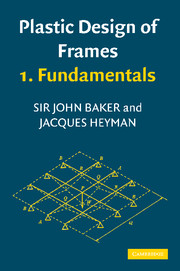6 - ASSUMPTIONS AND AIMS OF PLASTIC DESIGN
Published online by Cambridge University Press: 06 July 2010
Summary
Plastic theory has been presented here mainly with reference to framed structures, in which the action of external loads is resisted primarily by bending of the members. The theory can be applied successfully to other types of structure; this should be borne in mind, although these concluding remarks will continue to refer mainly to beams and frames.
The main object of plastic methods is to calculate the collapse loads of structures. Thus, of a large number of possible design criteria, plastic theory concentrates on one only, that of strength. In its simple form, the theory makes no attempt to assess deflexions, nor to enquire into the stability of individual members or of the structure as a whole. Thus, if he is to use plastic design methods, the designer must be satisfied that the particular structure under consideration is one for which strength is the overriding design criterion. Having designed the structure on the basis of plastic theory, the designer may, of course, estimate deflexions under working load, check the stability of members, and make any other calculations that seem to him to be desirable.
There is, however, rather more to the matter than a general and perhaps vague feeling on the designer's part that his structure should be suitable for plastic design. Firm reliance can only be placed on the plastic calculations if deflexions are small in a very definite technical sense and if the danger of instability is negligible.
- Type
- Chapter
- Information
- Plastic Design of Frames 1 Fundamentals , pp. 215 - 220Publisher: Cambridge University PressPrint publication year: 1969



